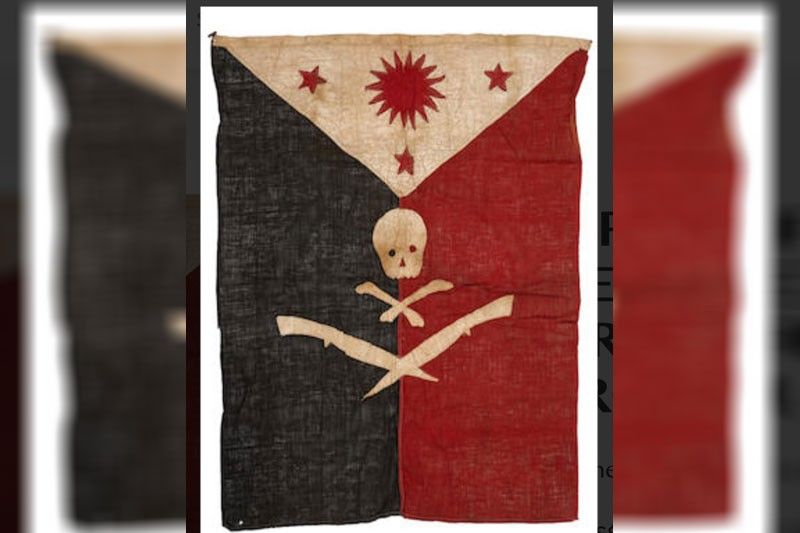Skull on flag & strands of hair of a saint at León online auction


Auctions are not just a hunting ground for important art but also a source of rare artifacts. These fragments of history are signposts and clues of our own mortality — as well as symbols of our nation’s very immortality.
Two interesting objects are featured at the León Exchange online auction this Jan. 18 and 19. (Previews are ongoing at Warehouse 14 — which is one of the biggest hives of art and antiques — at the La Fuerza Compound, Chino Roces Ave., Makati.)
In 1911, writes National Artist for Literature, Resil B. Mojares: “A fine arts student at the University of the Philippines, Guillermo Tolentino drew a composite portrait of ‘Illustrious Filipinos (Filipino Ilustres).’ The artist’s uncle submitted the portrait for publication to Severino Reyes, editor of the Liwayway, a popular Tagalog magazine. Reyes thought that it was best put out as a poster and offered it to the leading printing house in Manila, Carmelo and Bauermann. The painter, Jorge Pineda, who worked for the printing house, transferred the drawing to lithographic stone, and pulled in sepia, ‘Grupo de Filipinos Ilustres’ was printed in a first edition of 1,500 copies and sold at P0.80 each.”
The schoolboy’s poster quickly captured the country’s hearts — and homes. Tolentino himself said he was pleased to see his work in people’s living rooms everywhere.
Mojares goes on to say that this first pantheon of Filipino heroes was a significant cornerstone in our cultural history, a pre-requisite to the formation of our national identity. Thirteen heroes have been put together in a dream occasion including Jose Rizal, Andres Bonifacio, the two Luna brothers (Juan and Antonio), Apolinario Mabini, Graciano Lopez Jaena, Padre Jose Burgos, Marcelo H. del Pilar — as well as the so-called “men of the hour,” the personalities that Mojares noted happened to be in the news in 1911. These were General Miguel Malvar, Clemente Jose Zulueta, Antonio Ma. Regidor, Jose Ma. Basa, and Pedro Paterno, who perished or returned to the country in that year.
This depiction of the saints of the Philippine Revolution also features the work of some of the demi-gods of Filipino art. Guillermo Tolentino would go on to create the Bonifacio “Monumento” in Caloocan; the titan of illustration, Jorge Pineda, was Amorsolo’s mentor at the equally legendary firm of Carmelo and Bauermann.
Also remarkable is a collection of 24 photographs, from the period of the Philippine-American War. Many come from Neely’s famous album, “Fighting in the Philippines”, including an assortment that seem to be different angles of the same artillery-pockmarked strongholds, bullet-ridden corpses and Filipino cemeteries. There are also more peaceful photographs of Manila such as the Escolta and American troops lounging in ricefields. Others are “cabinet-card” photographs of “Tagala” (Tagalog) lasses. The album is also a highlight at the León Exchange auction.
There is a tantalizing reliquary, also set to go on the block, containing a few strands of hair from the head of Saint Bernadette (Soubirous) of Lourdes. It is contained in an elegant silver and bronze canister dating from the 19th century.
Just before the end of 2019, an international auction house featured memorabilia under the headline, “Conflicts of the 19th and 20th Centuries.” These included the Spanish-American War, the following Philippine-American, World War II and also the Boxer Rebellion and the Vietnam War.
Of the 89 lots, there were two standouts: war flags from the Philippines and a set of safety and arming plugs for the first atomic bomb to be dropped on Japan. The plugs belonged to the infamous “Little Boy” that devastated Hiroshima. They were certified authentic by the Weapons Test Officer who manually armed the bomb and were subsequently given to his superior officer, along with an account of the historic flight of the “Enola Gay.” Only three sets are known to exist; and this set was auctioned for $100,000 or the equivalent of five million pesos, reflecting its rarity and historical significance.
Outclassing the other offerings in hammer price, however, happened to be flags from the Philippine-American War, indicating Filipino keen interest in this watershed political event that was America’s first colonial adventure.
An almost-poetic Philippine-American War battle standard in red, black and white recalled the Katipunan initiation insignia of a skull and the KKK’s deadly intent. Crossed bolos made this banner more fearsome. When one contemplates that there was no National Historical Commission at the time issuing tiresome reminders of the do’s and don’ts of flag-making — and that these flags were made in the run-and-gun of the field — these symbols show how they have tapped directly into our common consciousness. That flag was auctioned for the stunning amount of nearly P2 million.
Also evocative was a banner belonging to the fighters of the Sultan of Sulu, which wonderfully mimicked the American foe’s own flag. It has a blue square field with its own five stars, representing the islands of the Sultanate, Sabah, Kalimantan, Palawan, Basilan and Sulu.
These Filipino flags did better than amazing artifacts from the Battle of the Bulge and D-Day, including a pair of battered road signs that pointed the way to Bastogne. (‘Band of Brothers’ fans will know exactly where this is and how important its siege was to World War II history.) These went for P1.6 Million. Other must-haves for history buffs included tattered Normandy Landing stars and stripes (auctioned off from P500,000 to P1 Million each) and even a British spy map on silk of Nazi Berlin.
Indeed, why shouldn’t our flags take center-stage? They must have astonished the American army composed mainly of troops hardened by wars with the Apaches and the Sioux. Filipinos, on the other hand, had the capacity to communicate their standing as a proud and independent nation through their flags, elaborate uniforms (hats, epaulettes, even French-style rosettes), and declarations embellished with letterheads, stamps and seals. It is, after all, in these symbols that a nation’s sovereignty is born.
Now to turn our attention to the truly elusive: Two books — excruciatingly not for sale at any price — saw print at the turn of the new decade. The first, published by collector JJ Atencio’s Januarius Holdings, focuses on the Art and Times of the Seventies. It features essays by author and bank president Jaime C. Laya, independent art critic Marian Pastor Roces, museum head Corazon S. Alvina, social historian Augusto “Toto” Gonzalez and yours truly. Over 30 works from the Atencio-Libunao Art Collection are featured including works by BenCab, Napoleon Abueva, and Vicente Manansala.
In time for the recent Fiesta de Quiapo is a luxuriously printed set composed of two hefty volumes on the Paterno family, entitled By Their Deeds: The Paternos of the Spanish Era. Authored by Jean Marie Yap Paterno and Miguel Roces Paterno, it documents the grandees of several centuries ago who remain influential, colorful, and moneyed to this day. Among the delicious morsels is a list of their Luna paintings and the amounts paid for them in gold coin. Will these books end up, sooner than later, on our favorite auction floor?



















